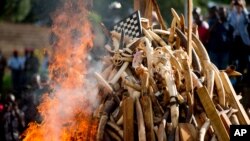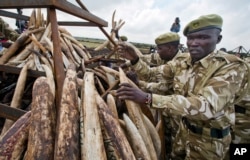Some 2,000 illegally trafficked elephant tusks and hundreds of finished ivory products erupted in a ball of fire Tuesday as Cameroonian authorities conducted what was believed to be one of the largest burnings of poached wildlife goods in African history.
Setting the pyre aflame in a sandy square in Cameroon's capital, Samantha Power, America's U.N. ambassador, joined Cameroonian officials in hailing the ceremony as symbolic of their commitment to win the war against illegal smuggling of animal products.
Central Africa's forest elephants have declined in number by two-thirds between 2002 and 2012.
“All of our countries can and must do more,” Power said. The burning sends a clear message, she added, that “the only place ivory belongs and the only value ivory has is on elephants.”
Heap of poached goods
The heap included ivory chess boards, beads, totem poles and even miniature elephant sculptures, all intermixed with the raw tusks. Cameroonian officials said the pile totaled 3.5 tons of tusk alone, though that figure couldn't be verified. What's certain is the merchandise was worth millions of dollars. The pyre will burn for three days.
Philip Ngole Ngwese, Cameroon's minister of forestry and wildlife, said the seized tusks and ivory, much of which originated abroad, were now “beyond reach.” He also described the human costs of poaching, mourning several guides and park rangers who have been killed in recent years.
Cameroon's biggest city, Douala, is a port through which much of the region's trafficked goods transit overseas.
Power, on a weeklong trip to promote the battle against the Muslim extremist group Boko Haram, also met President Paul Biya and other senior Cameroonian officials. She announced $40 million in new U.S. humanitarian aid to the region.
The United States has some 200 special operations forces in Cameroon advising and assisting African troops in the fight. Power, making the first trip to the country by a U.S. Cabinet member in a quarter-century, stressed the need for Cameroonian soldiers to exercise restraint amid reports they've sometimes targeted civilians.
“Any fight against terrorism has to be comprehensive,” she said, echoing remarks she made in Cameroon's embattled north on Monday. Political inclusiveness, good governance, economic development and combatting extremism at the grassroots level, she said, “are every bit as critical as one's military campaign itself.”
Pyre
Smoke billowed from the pyre as the ivory tusks turned black and statuettes smoldered.
Ivory-burning ceremonies aren't a gesture universally appreciated - even in Cameroon. Some wonder why the valuable tusks aren't reused in some capacity, given the elephants are already dead.
Echoing such sentiments, one local journalist asked Power why the tusks aren't preserved in museums for future generations that may never see elephants.
“I don't want to think about contingency plans for if elephants are eliminated from the wild,” Power said.
The event and Power's participation underscored the Obama administration's effort to prioritize the fight against wildlife trafficking. In doing so, it is trying to break a multibillion-dollar criminal industry that officials say sometimes interweaves with drug trafficking and even terrorist enterprises. The U.S. held its own ivory crushes in 2013 and 2015.
In March, a U.S. task force said a “turning point” had been reached in the global endeavor to strengthen enforcement, reduce demand and expand international cooperation. But much ultimately depends on China cracking down, because its citizens are driving global demand.
As a port of exit, Cameroon plays a major role in snuffing out ivory smuggling from Central Africa, where several countries are struggling to assert control over their own territory, and national parks are often poorly protected. Cameroon, too, has suffered from poaching.
Four years ago, armed poaching gangs from Sudan massacred more than half of the elephants in the Bouba Njida National Park in northern Cameroon. The raids highlighted the vulnerability of elephants even in stable African countries. Biya, who is 83, has ruled Cameroon for more than 30 years.












